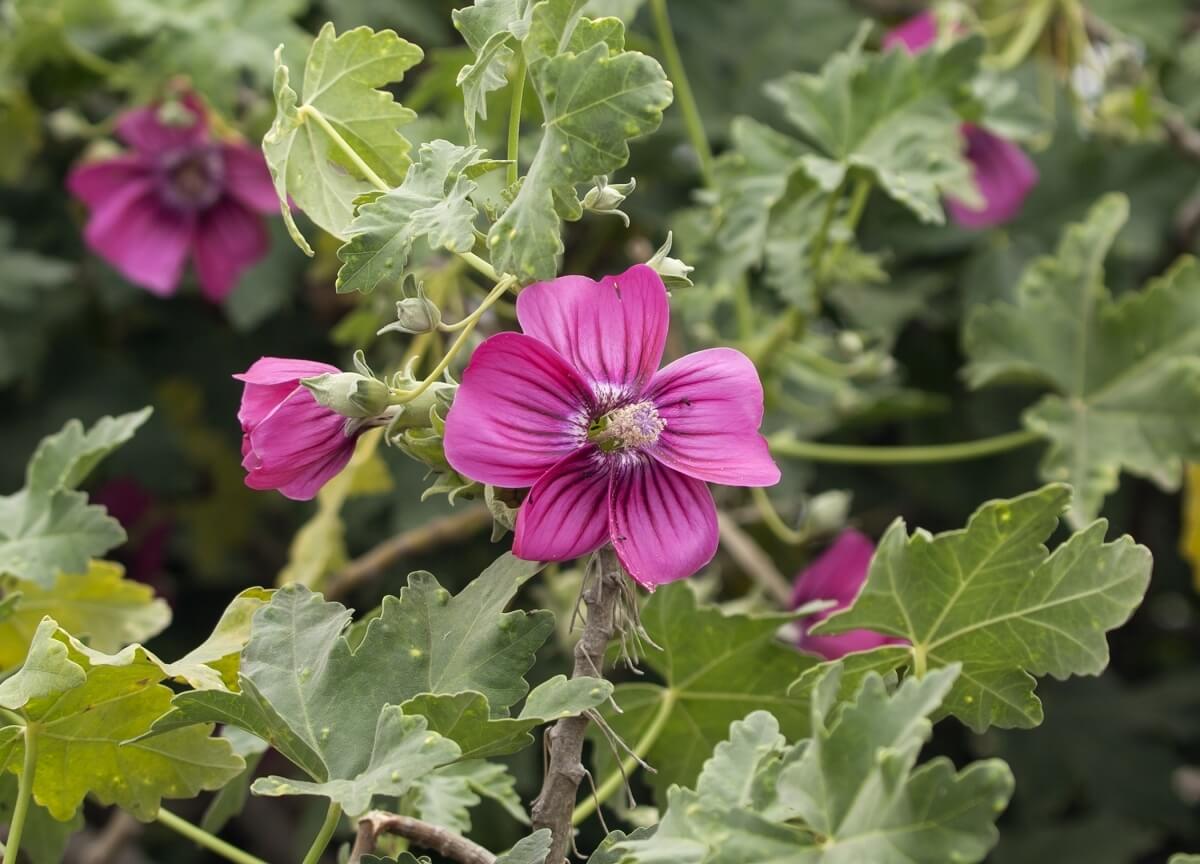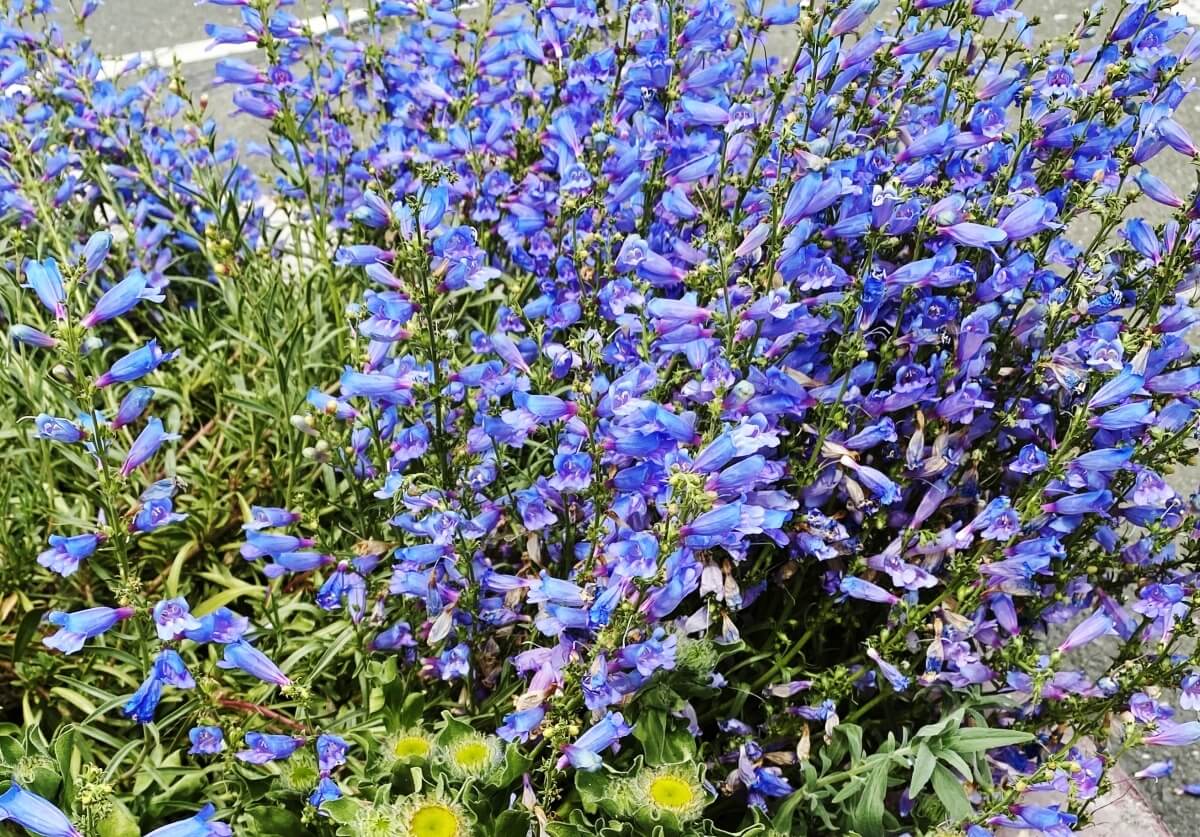Linum lewisii
A beautiful Western perennial, perfect for the border or in a meadow blended with bunchgrasses, poppies, clarkia and flowering bulbs. Summer blooming, flowers open over a long time; full sun, low water, 12-18” tall, needs good drainage, deer ignore it.
Blue Flax is ordinarily seen growing wild in meadows and grassy fields; and in these conditions it is a small plant, usually no more than a few linear stalks with a cluster of flower buds that open daily. In a controlled garden situation the plant becomes much more substantial, with multiple stalks emerging from an enlarging clump.
The seeds are a medium size; so they can be tamped down into a starter mix, and very lightly covered with a sprinkling of vermiculite or perlite. I sow the seeds in a 4” pot, outside in a protected situation; either in late summer or in early spring. The seeds germinate within two weeks, and then need another two or three months to develop into a sturdy seedling ready to transplant to a garden bed, or a container.
Malva (Lavatera) assurgentiflora
A fast growing shrub displaying hibiscus-like flowers much of the year. Adds a tropical look. Grow in a frost-free location. Prune back annually to keep it to an attractive form. Adaptable to most soils; 5 to 0 feet high, full sun, needs good drainage, protect from deer.
This plant is very easy to start from seed; and can grow into a large shrub within a year. Seeds can be started outdoors in late summer (as long as you can protect them during the cold season) or in early spring. The seed is large, so cover it with about 1/8” of soil, then top that off with a light covering of perlite or vermiculite; and then tamp it all down for good seed to soil contact. Germination occurs within about 10 to 14 days; the cotyledons are tiny heart-shaped leaves; the true leaves take on a maple-like shape.
Transplant the seedlings to larger pots when they are about 3 to 4” tall. The seedlings are safe from most predators; but the mature plant is not! The leaves are basically deer food; and rodents love to nibble away at the bark. Be sure to grow this mallow within a fenced area, and place it away from known rodent runways.
Penstemon heterophyllus
The flowers of this native penstemon are almost electric blue and very profuse. Very showy in spring; ideal when planted with poppies and other wildflowers. Tolerates average garden water and most soils. Very attractive to pollinators. Gets 15” tall and wide; needs full sun, good drainage.
The seed is small, but needs no pre-germination treatment when sown outside in early fall. Prepare your seed-starting mixture, tamping it down solidly into the pot; rough the surface just a bit and sprinkle the seed on the surface. Then cover it with a thin layer of perlite or vermiculite, and tamp that down over the seed.
Germination is somewhat slow; it can be 6 to 8 weeks before the first seedlings appear. I usually use plastic nursery pots or flats to start seeds; but they keep the soil really moist, and sometimes also soggy at the bottom; and this may be detrimental to the early growth of the seedlings. I’ve been using a clay ‘bulb’ pot (large in diameter, but shallow) to germinate and grow on the penstemon seedlings, and getting better results.
I set my seed pot outside in a somewhat shady and protected place; either watering only once when I set it all up; and then letting the rainy season take over: Or, I’ll put the pot on my seedling bench, where I have systems set for a light watering once a day. Within two months or so, after germination, the seedlings will be large enough to transplant to individual pots. Note the nice reddish color on the healthy young stems.
Salvia apiana
A dramatic plant with striking, pale blue-green, aromatic foliage and tall spires of white flowers. Very adaptable as long as the drainage and air circulation is good. Cut back in winter. Excellent pollinator plant; deer proof. Full sun, low water, 4 x 4 feet or more when mature.
White Sage is a strikingly beautiful shrub with very aromatic leaves, and flowers that, though small, are profuse and loved by the bees. It’s a plant native to the much drier, hotter chaparral of Southern California.
Salvia spathacea
A magnet for hummingbirds when in bloom in late spring, Hummingbird Sage is a perfect groundcover in the light shade of a deciduous tree. It will go summer dormant if not irrigated. Deer don’t touch it! Spreads by runners to form a patch 1-2’ tall by 4 or more feet wide.
Salvia spathacea ‘Avis Keedy’
An unusual yellow form of Hummingbird Sage.
Hummingbird Sages set their large flowers on spires that are easily accessible to the hummingbirds. This Salvia is endemic to California with a natural range that begins at San Bruno Mountain, and extends south to Orange County. In its natural habitat it colonizes somewhat shady areas (unusual for California Salvias) and soils rich with humus.






